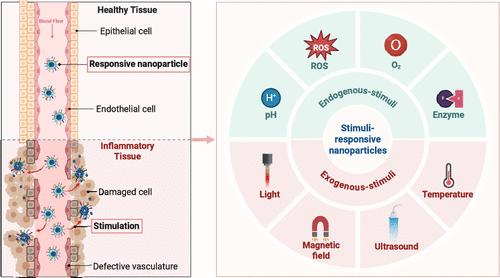刺激反应纳米药物治疗非癌症相关炎症性疾病
IF 16
1区 材料科学
Q1 CHEMISTRY, MULTIDISCIPLINARY
引用次数: 0
摘要
纳米药物通过提供药物保护、增强药物生物利用度和靶向药物递送到受影响部位,提供了一种克服与传统药物剂量配方相关的局限性的手段。炎症组织具有独特的微环境特征(包括过多的活性氧、低pH值和缺氧),刺激反应性纳米颗粒可以作为触发器来支持按需递送、增强积累、控制释放和抗炎药物的激活。刺激反应性纳米药物通过对病变组织相关的物理化学和病理因素的响应,提高给药的特异性,克服多药耐药,保证准确诊断和精准治疗,控制药物释放,提高疗效和安全性。电流刺激响应纳米颗粒对细胞内/微环境刺激(如pH、氧化还原、缺氧或特定酶)和外源刺激(如温度、磁场、光和超声波)通过生物响应部分作出反应。本文综述了针对炎症性疾病生产刺激反应性纳米颗粒的一般策略和所有最新进展,报告了它们在药物传递中的应用,并说明了临床转化的进展。本文章由计算机程序翻译,如有差异,请以英文原文为准。

Stimuli-Responsive Nanomedicines for the Treatment of Non-cancer Related Inflammatory Diseases
Nanomedicines offer a means to overcome the limitations associated with traditional drug dosage formulations by affording drug protection, enhanced drug bioavailability, and targeted drug delivery to affected sites. Inflamed tissues possess unique microenvironmental characteristics (including excessive reactive oxygen species, low pH levels, and hypoxia) that stimuli-responsive nanoparticles can employ as triggers to support on-demand delivery, enhanced accumulation, controlled release, and activation of anti-inflammatory drugs. Stimuli-responsive nanomedicines respond to physicochemical and pathological factors associated with diseased tissues to improve the specificity of drug delivery, overcome multidrug resistance, ensure accurate diagnosis and precision therapy, and control drug release to improve efficacy and safety. Current stimuli-responsive nanoparticles react to intracellular/microenvironmental stimuli such as pH, redox, hypoxia, or specific enzymes and exogenous stimuli such as temperature, magnetic fields, light, and ultrasound via bioresponsive moieties. This review summarizes the general strategies employed to produce stimuli-responsive nanoparticles tailored for inflammatory diseases and all recent advances, reports their applications in drug delivery, and illustrates the progress made toward clinical translation.
求助全文
通过发布文献求助,成功后即可免费获取论文全文。
去求助
来源期刊

ACS Nano
工程技术-材料科学:综合
CiteScore
26.00
自引率
4.10%
发文量
1627
审稿时长
1.7 months
期刊介绍:
ACS Nano, published monthly, serves as an international forum for comprehensive articles on nanoscience and nanotechnology research at the intersections of chemistry, biology, materials science, physics, and engineering. The journal fosters communication among scientists in these communities, facilitating collaboration, new research opportunities, and advancements through discoveries. ACS Nano covers synthesis, assembly, characterization, theory, and simulation of nanostructures, nanobiotechnology, nanofabrication, methods and tools for nanoscience and nanotechnology, and self- and directed-assembly. Alongside original research articles, it offers thorough reviews, perspectives on cutting-edge research, and discussions envisioning the future of nanoscience and nanotechnology.
 求助内容:
求助内容: 应助结果提醒方式:
应助结果提醒方式:


